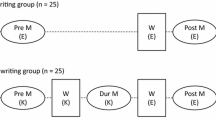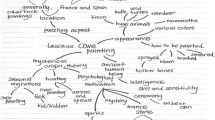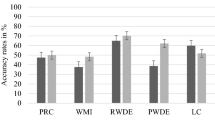Abstract
Previous research has shown that the knowledge structure (KS) complexity of a first language (L1) under certain conditions can strongly influence the KS complexity established in a second language (L2), and then this more complex L2 KS reciprocally influences L2 text comprehension. This present experimental investigation seeks to identify the unique contributions of mapping and writing in L1 (Korean) tasks to support L2 (English) science text comprehension using Pathfinder Network scaling, a graph-theoretic cognitive science approach. Native Korean low proficiency English language learners (n = 245) read a 708-word English (L2) science lesson text, completed one of seven treatment conditions, and then completed a comprehension posttest. The seven conditions consisted of three experimental conditions that required different L1 tasks including: L1 mapping alone, L1 writing alone, or both L1 mapping and writing; and four control conditions that did not receive any L1 treatment: L2 mapping alone, L2 writing alone, both L2 mapping and writing, or reading only. All of the maps and writing artifacts were converted into Pathfinder Networks that were compared to an expert’s referent network. Results show that requiring L1 lesson tasks relatively increases L2 KS complexity and concomitant comprehension posttest performance. In order of effectiveness, combined L1 mapping and writing was most effective for posttest comprehension, then L1 writing, and least effective is L1 mapping alone. These findings confirm and extend the earlier findings that the inherent L1 KS complexity can strongly influence L2 KS complexity. Educationally, requiring L1 tasks, especially in text translation, likely engenders richer L2 structure that supports higher-order understanding of the text. Also, these findings further validate this technology-based approach for measuring KS contained in bilingual learners’ productions.








Similar content being viewed by others
References
Anton, M., & DeCamilla, F. (1998). Socio-cognitive functions of L1 collaborative interaction in the L2 classroom. Canadian Modern Language Review, 54, 314–342. https://doi.org/10.1111/0026-7902.00018.
Barb, A. S., Clariana, R. B., & Chi-Ren, S. (2013). Applications of PathFinder Network Scaling for improving the ranking of satellite images. IEEE Journal of Selected Topics in Applied Earth Observations and Remote Sensing, 6(3), 1092–1099.
Brooks, F. B., & Donato, R. (1994). Vygotskyan approaches to understanding foreign language learner discourse during communicative tasks. Hispania, 77, 262–274. https://doi.org/10.2307/344508.
Brysbaert, M., & Duyck, W. (2010). Is it time to leave behind the Revised Hierarchical Model of bilingual language processing after fifteen years of service? Bilingualism: Language and Cognition, 13, 359–371.
Chee, M. W. L., Hon, N., Lee, H. L., & Soon, C. S. (2001). Relative language proficiency modulates BOLD signal change when bilinguals perform semantic judgments. NeuroImage, 13, 1155–1163. https://doi.org/10.1006/nimg.2001.0781.
Clariana, R. B., Engelmann, T., & Yu, W. (2013). Using centrality of concept maps as a measure of problem space states in computer-supported collaborative problem solving. Educational Technology Research and Development, 61, 423–442.
Clariana, R. B., & Koul, R. (2004). A computer-based approach for translating text into concept maplike representations. In Proceedings of the first international conference on concept mapping (pp. 14–17).
Clariana, R. B., & Koul, P. (2008). The effects of learner prior knowledge when creating concept maps from a text passage. International Journal of Instructional Media, 35, 229–236.
Clariana, R. B., & Taricani, E. M. (2010). The consequences of increasing the number of terms used to score open-ended concept maps. International Journal of Instructional Media, 37, 163–173.
Clariana, R. B., Wallace, P. E., & Godshalk, V. M. (2009). Deriving and measuring group knowledge structure from essays: The effects of anaphoric reference. Educational Technology Research and Development, 57, 725–737.
Clariana, R. B., Wolfe, M. B., & Kim, K. (2014). The influence of narrative and expository text lesson text structures on knowledge structures: Alternate measures of knowledge structure. Educational Technology Research and Development, 62, 601–616.
Cohen, A. D., & Brooks-Carson, A. (2001). Research on direct versus translated writing: Students’ strategies and their results. The Modern Language Journal, 85, 169–188. https://doi.org/10.1111/0026-7902.00103.
Coronges, K. A., Stacy, A. W., & Valente, T. W. (2007). Structural comparison of cognitive associative networks in two populations. Journal of Applied Social Psychology, 37(9), 2097–2129.
Cronbach, L. J., & Meehl, P. E. (1955). Construct validity in psychological tests. Psychological Bulletin, 52(4), 281. https://doi.org/10.1037/h0040957.
Cumming, A. (1990). Metalinguistic and ideational thinking in second language composing. Written Communication, 7, 482–511. https://doi.org/10.1177/0741088390007004003.
Draper, D. C. (2013). The instructional effects of knowledge-based community of practice learning environment on student achievement and knowledge convergence. Performance Improvement Quarterly, 25(4), 67–89.
Engelmann, T., & Hesse, F. W. (2010). How digital concept maps about the collaborators’ knowledge and information influence computer-supported collaborative problem solving. International Journal of Computer-Supported Collaborative Learning, 5(3), 299–319.
Fesel, S. S., Segers, E., Clariana, R. B., & Verhoeven, L. (2015). Quality of children’s knowledge representations in digital text comprehension: Evidence from pathfinder networks. Computers in Human Behavior, 48, 135–146. https://doi.org/10.1016/j.chb.2015.01.014.
Gonzalvo, P., Canas, J. J., & Bajo, M. (1994). Structural representations in knowledge acquisition. Journal of Educational Psychology, 86, 601–616. https://doi.org/10.1037/0022-0663.86.4.601.
Ifenthaler, D. (2010). Relational, structural, and semantic analysis of graphical representations and concept maps. Educational Technology Research and Development, 58, 81–97. https://doi.org/10.1007/s11423-008-9087-4.
Jamieson, J., Enright, M., & Chapelle, C. (2008). Building a validity argument for the Test of English as a Foreign Language. New York: Routledge.
Jones, S., & Tetroe, J. (1987). Composing in a second language. In A. Matsuhashi (Ed.), Writing in real time: Modelling production processes (pp. 34–57). Norwood, NJ: Ablex.
Karim, K. (2010). First language (L1) influence on second language (L2) reading: The role of transfer. Working Papers of the Linguistics Circle, 17, 49–54.
Kim, M. K. (2012). Cross-validation study of methods and technologies to assess mental models in a complex problem solving situation. Computers in Human Behavior, 28(2), 703–717.
Kim, K. (2017a). Visualizing first and second language interactions in science reading: A knowledge structure network approach. Language Assessment Quarterly, 14, 328–345.
Kim, K. (2017b). Graphical interface of knowledge structure: A web-based research tool for representing knowledge structure in text. Technology, Knowledge and Learning. https://doi.org/10.1007/s10758-017-9321-4.
Kim, K. (2017c). An automatic measure of cross-language text structures. Technology, Knowledge and Learning. https://doi.org/10.1007/s10758-017-9320-5.
Kim, K., & Clariana, R. B. (2015). Knowledge structure measures of reader’s situation models across languages: Translation engenders richer structure. Technology, Knowledge and Learning, 20, 249–268.
Kim, K., & Clariana, R. B. (2016). Text signals influence second language expository text comprehension: Knowledge structure analysis. Educational Technology Research and Development. https://doi.org/10.1007/s11423-016-9494-x.
Kim, K., Clariana, R. B., Alqahtani, M. A., & Tang, H. (2016). Revealing knowledge structure in lesson texts using a computational text pattern-matching approach. Paper presented at the annual meeting of the Association for Educational Communication and Technology (AECT), Jacksonville, FL.
Kobayashi, H., & Rinnert, C. (1992). Effects of first language on second language writing: Translation versus direct composition. Language Learning, 42, 183–215. https://doi.org/10.1111/j.1467-1770.1992.tb00707.x.
Li, P., & Clariana, R. B. (2018). Reading comprehension in L1 and L2: An integrative approach. Journal of Neurolinguistics.
Li, P., Zhang, F., Tsai, E., & Puls, B. (2014). Language history questionnaire (LHQ 2.0): A new dynamic web-based research tool. Bilingualism: Language and Cognition, 17(03), 673–680. https://doi.org/10.1017/s1366728913000606.
Pennington, M., & So, S. (1993). Comparing writing process and product across two languages: A study of six Singaporean university student writers. Journal of Second Language Writing, 2, 41–63. https://doi.org/10.1016/1060-3743(93)90005-N.
Poindexter, M. T., & Clariana, R. B. (2006). The influence of relational and proposition-specific processing on structural knowledge and traditional learning outcomes. International Journal of Instructional Media, 33, 177–184.
Qi, D. S. (1998). An inquiry into language-switching in second language composing processes. The Canadian Modern Language Review, 54, 413–435. https://doi.org/10.3138/cmlr.54.3.413.
Reyna, V. F., & Brainerd, C. J. (1995). Fuzzy-trace theory: An interim synthesis. Learning and Individual Differences, 7, 1–75.
Roca de Larios, J., Murphy, L., & Manchon, R. (1999). The use of restructuring strategies in EFL writing: A study of Spanish learners of English as a Foreign Language. Journal of Second Language Writing, 8, 13–44. https://doi.org/10.1016/S1060-3743(99)80111-8.
Ryan, C. (2013). American Community Survey Reports: Language Use in the United States: 2011. https://www.census.gov/prod/2013pubs/acs-22.pdf
Sarwar, G. S. (2011). Structural assessment of knowledge for misconceptions: Effectiveness of structural feedback provided by pathfinder networks in the domain of physics. Kolln: LAP Lambert Academic Publishing.
Schmidt, S. (2009). Shall we really do it again? The powerful concept of replication is neglected in the social sciences. Review of General Pscyhology, 13, 90–100. https://doi.org/10.1177/1745691613514450.
Spector, J. M., Johnson, T. E., & Young, P. A. (2015). An editorial on replication studies and scaling up efforts. Educational Technology Research and Development, 63, 1–4. https://doi.org/10.1007/s11423-014-9364-3.
Stahl, G. (2010). Group cognition as a foundation for the new science of learning. In M. S. Khine & I. M. Saleh (Eds.), New science of learning: Cognition, computers, and collaboration in education (pp. 23–34). New York, NK: Springer.
Tang, H., & Clariana, R. (2017). Leveraging a sorting task as a measure of knowledge structure in bilingual settings. Technology, Knowledge and Learning, 22(1), 23–35.
Taricani, E. M., & Clariana, R. B. (2006). A technique for automatically scoring open-ended concept maps. Educational Technology Research and Development, 54, 61–78.
Tawfik, A. A., Law, V., Ge, X., Xing, W., & Kim, K. (2018). The effect of sustained vs. faded scaffolding on students’ argumentation in ill-structured problem solving. Computers in Human Behavior.
Tossell, C. C., Schvaneveldt, R. W., & Branaghan, R. J. (2010). Targeting knowledge structures: A new method to elicit the relatedness of concepts. Cognitive Technology, 15(2), 11.
Tse, C. S., & Altarriba, J. (2012). The effects of first-and second-language proficiency on conflict resolution and goal maintenance in bilinguals: Evidence from reaction time distributional analyses in a Stroop task. Bilingualism: Language and Cognition, 15(03), 663–676.
Uzawa, K., & Cumming, A. (1989). Writing strategies in Japanese as a foreign language: lowering or keeping up the standards. The Canadian Modern Language Review, 46, 178–194.
van Hell, J. G., & Kroll, J. F. (2013). Using electrophysiological measures to track the mapping of words to concepts in the bilingual brain: a focus on translation. Cambridge: Cambridge University Press. Retrieved from http://repository.ubn.ru.nl/handle/2066/116759
Wang, L. (2003). Switching to first language among writers with differing second-language proficiency. Journal of Second Language Writing, 12, 347–375. https://doi.org/10.1016/j.jslw.2003.08.003.
Wang, W., & Wen, Q. (2002). L1 use in the L2 composing process: An exploratory study of 16 Chinese EFL writers. Journal of Second Language Writing, 11, 225–246. https://doi.org/10.1016/S1060-3743(02)00084-X.
Woodall, B. R. (2002). Language-switching: Using the first language while writing in a second. Journal of Second Language Writing, 11, 7–28. https://doi.org/10.1016/S1060-3743(01)00051-0.
Zhao, X., & Li, P. (2013). Simulating cross-language priming with a dynamic computational model of the lexicon. Bilingualism: Language and Cognition, 16, 288–303.
Zimmerman, W. A., Kang, H. B., Kim, K., Gao, M., Johnson, G., Clariana, R., et al. (2018). Computer-automated approach for scoring short essays in an introductory statistics course. Journal of Statistics Education, 26(1), 40–47.
Author information
Authors and Affiliations
Corresponding author
Ethics declarations
Conflict of interest
The authors declare that they have no conflict of interest.
Rights and permissions
About this article
Cite this article
Kim, K., Clariana, R.B. Applications of Pathfinder Network scaling for identifying an optimal use of first language for second language science reading comprehension. Education Tech Research Dev 67, 85–103 (2019). https://doi.org/10.1007/s11423-018-9607-9
Published:
Issue Date:
DOI: https://doi.org/10.1007/s11423-018-9607-9




